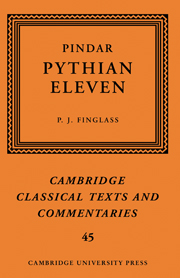5 - Metrical analysis
from INTRODUCTION
Published online by Cambridge University Press: 05 August 2015
Summary
The practice of dividing up a written poetic text into its constituent metrical units was unknown in Pindar's day. The first attempts to introduce line-division (or colometry) did not occur until the Hellenistic period, more than two hundred years after the poet's death. The scholars responsible for the edition of Pindar drawn up then are most unlikely to have possessed information going back to Pindar's time which could help them identify where the metrical pauses fell. As a result, the ancient colometry preserved in our mediaeval manuscripts does not provide authoritative information for the metrical division known and appreciated by Pindar's audiences. Since nothing in it goes back to Pindar, we cannot use it as evidence for his colometry. Consequently, as we attempt to describe the metrical shape of Pythian Eleven, we must be guided not by ancient scholarship, but by the contents and shaping of the ode itself.
The key advance in our understanding of Pindar's colometry took place with Boeckh's 1811 edition. Boeckh identified the period (or verse), ‘the fundamental self-contained unit in metrical composition’ (West (1982) 5). Its basic characteristics, set out by West (1982) 4–5, are as follows. (i) It begins and ends with the boundary of a word, and often with a syntactic break. (ii) Its contents are all in synapheia: that is, they make up a single unit when determining prosody, without regard for word breaks. (iii) There is no synapheia between periods. As a result, the juncture between two periods may involve hiatus, brevis in longo or anceps iuxta anceps, none of which is normally acceptable within periods. The periods of Pythian Eleven are arranged in two repeated metrical patterns: one in the strophe and antistrophe, occurring eight times in all, and the other in the epode, which we encounter four times. Below I print my preferred colometry, and in what follows attempt to justify it.
- Type
- Chapter
- Information
- Pindar: 'Pythian Eleven' , pp. 47 - 56Publisher: Cambridge University PressPrint publication year: 2007



